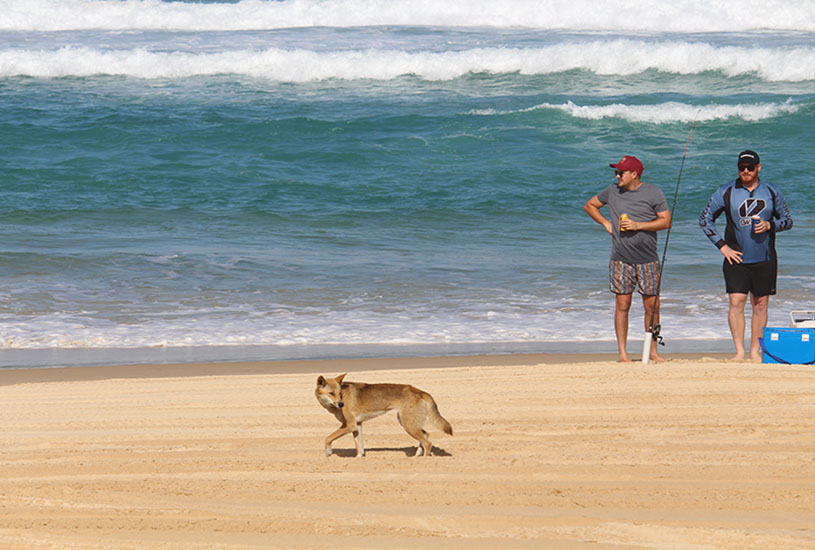A major study has revealed a huge variation in dingo diets, and their predation of threatened species.
From insects and snakes, to kangaroos and camels, a huge range of species are eaten by dingoes. Our top predator dines out on at least 229 different vertebrate species, including dozens of threatened animals, as well as introduced pests.In Australia’s largest, most comprehensive study of the diet of the dingo, researchers at Deakin University found dingoes ate 39 native species that are classed as threatened or near threatened on the International Union for Conservation of Nature “Red List”. These include the northern quoll, golden bandicoot and bridled nail-tail wallaby.
However, this doesn’t mean farmers or wildlife managers should reach for their shot guns. Project leader Dr Tim Doherty, a Research Fellow within Deakin’s Centre for Integrative Ecology, says that dingoes can play an important role in reducing introduced invasive species and overabundant native animals like kangaroos. He suggests different parts of the nation need localised strategies to protect threatened species and reduce pests in their wildlife management plans.
Although current threatened species coexisted with dingoes prior to European colonisation, he explained, they are more vulnerable now due to smaller population sizes and new pressures such as predation from cats and foxes.
“The sheer number and range of animals we found recorded in dingo diets was amazing,” said Dr Doherty.
“32,000 dingo scats or stomach contents were analysed. Large and medium-sized mammals were the most common components of dingo diets, followed by small mammals and rabbits. We found that dingoes had fed on 62 small mammal species, 79 medium and large mammals, 10 introduced hoofed mammals, 50 birds and 26 different types of reptile.”
The true number of species eaten by dingoes, however, is likely to be much higher because dingo diets have been poorly studied in many parts of Australia, such as the Cape York Peninsula. Dingoes also eat insects, crustaceans, centipedes, fish and frogs, which are hard to identify in dietary samples.
“Our findings mean that predation by dingoes must be a key consideration when populations of threatened species are being established outside of predator-free reserves,” Dr Doherty said.
[testimonial_text]The sheer number and range of animals we found recorded in dingo diets was amazing.[/testimonial_text]
[testimonial_picture name=”Dr Tim Doherty” details=”Project leader, Centre for Integrative Ecology”]
 [/testimonial_picture]
[/testimonial_picture]“However, it’s also important to consider the net effect of dingoes on species and ecosystems. Dingoes prey on a range of introduced pest species, including deer, goats, rabbits, hares, black rats, house mice, foxes and cats. They can also regulate populations of overabundant herbivores, like goats and kangaroos, which helps to reduce grazing pressure and conserve habitat structure for native species.
“Interestingly, dingoes have also increased their consumption of deer in recent decades, which have expanded their range. This is a good thing. Deer are an invasive pest causing damage to the natural environment and agricultural businesses.”
The research supports the description of dingoes as a “generalist predator,” meaning their diet is heavily influenced by local prey availability. For instance, in arid central Australia, birds, reptiles, rabbits, small mammals and insects are a major part of their diet, but these food groups are less important in temperate, sub-tropical eastern Australia where medium-sized and large mammals, such as kangaroos, bandicoots and possums, are more common.
This is probably due to the lower number of mammal extinctions in eastern Australia compared to central Australia, which is a global “extinction hotspot” for mammals.
One medium-sized mammal that is a major food item for dingoes in arid areas is the European rabbit. In some areas, more than half of dingo scats or stomachs contain rabbit remains.
Dr Doherty said that understanding regional variations could help predict how dingoes will adapt as prey communities change in the future, due to causes like climate change, larger populations of introduced species and habitat loss.
As to whether they eat wombat, as suggested in the popular Australian picture book, “Wombat Stew,” the answer is “of course.”
• Read more: “Mammal Review.”




